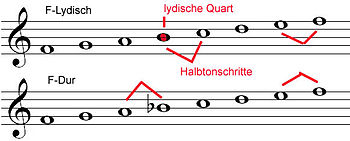Lydian mode
Lydian mode , Lydian for short (after the Lydians ), originally denotes an octave genre of the ancient Greek Systema Téleion , later the fifth tone or tritus authenticus (characterized by the ambitus ff 1 , the repercussa c 1 and the finalis f) in the medieval system of church tones .
Today (for example in modal jazz ) it is often only understood as a modal scale with the same interval structure.
Since the third degree of the Lydian scale forms a major third to the root note , it has a major- like character. There is a semitone step between the fourth and fifth as well as the seventh and eighth steps , the other intervals are whole steps .
The key of F-Lydian contains the original notes of Western music, which correspond to the white keys on keyboard instruments .
The Lydian mode corresponds to the Indian raga kalyana .
history
The Lydian scale originated in ancient Greece , was there but first hypolydisch or hypermixolydisch while later as Lydian ionic mode was called.
It was not until the early Middle Ages that the modes were confused due to a misunderstanding. Lydian was later used in Christian church music of the Middle Ages (for example in songs of Mary). In this tradition, the ethos of this key stands for the character of humble joy, faith or hope.

use
Classical music
The mode is used by some composers in classical music to achieve certain effects. An example in sacred choral music is the St. Luke Passion by Heinrich Schütz .
Jazz and rock music
After Miles Davis had written compositions in Phrygian and Doric (e.g. So What ), all other modal scales were soon included in the musical practice of jazz . In the area of harmonic expansion, which advanced jazz musicians spontaneously play e.g. B. a standard is made, Lydian can serve as a replacement for Ionic to create variety and tension. Lydian, as a " timbre ", has equal rights with all other scales, e.g. B. found its way into modern jazz as a major replacement. In this sense, Lydian is used by many musicians in their compositions, for example by Chick Corea , Steve Vai , Pat Metheny or Tom Harrell .
Usage examples can also be found in rock music , for example at Metallica . Pink Floyd guitarist David Gilmour uses Lydian scales in the instrumental Mihalis (from the Gilmour album ) and in the introduction to Cluster One from The Division Bell .
Audio sample and illustration
See also
- Usage examples
- on the “Lydian notation” cf. Doric notation
Web links
References and comments
- ↑ See Luigi Agustoni / Johannes Berchmans Göschl: Introduction to the Interpretation of Gregorian Chant , Volume 1: Basics, Chapter 1.3.2: The eight modes of the octo echo , Gustav Bosse Verlag, Kassel (1995)
- ↑ In addition to the correct spelling authenticus , the incorrect spelling authentus is also found quite often in the literature .
- ↑ Markus Bautsch: About the ethos of church tones . accessed on November 23, 2014
